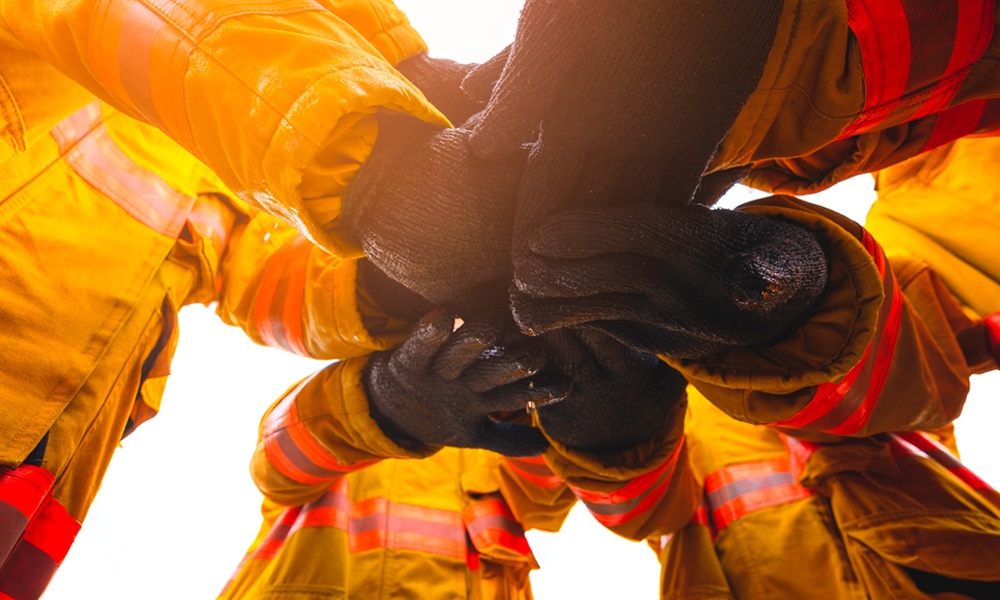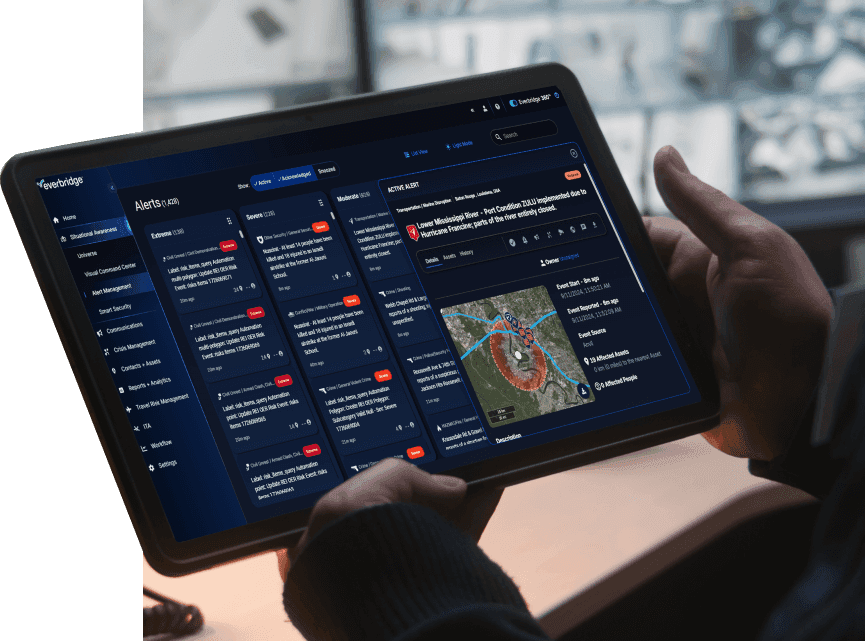By recognizing that hazards, including severe weather events, are unpredictable and cannot be completely prevented, emergency managers can instead focus their efforts on promoting a resilient organization. A community is resilient when it can recover from a disaster or other stressor and get back on its feet as quickly as possible.
There are many best practices for emergency managers to prepare for severe weather events such as hurricanes, floods, tornadoes, wildfires, and other risks. Preparing for hazards can involve planning and training with departments, jurisdictions, agencies, and community members.
To help you better understand how to promote resilience in your organization, Everbridge hosted a 4-part webinar series focused on the phases of emergency management: Mitigation, Preparedness, Response, and Recovery. For an overview, read on to learn the top seven best practices that emergency managers can implement to ensure severe weather preparedness.
1. Conduct a THIRA (thorough hazard identification and risk assessment) as part of your Hazard Mitigation Planning
A thorough hazard identification and risk assessment (THIRA) is a critical component of any disaster planning process. It provides a foundation for additional planning efforts and is an essential first step in the process of creating an emergency management plan.
Jenny Demaris of the Lincoln County Sheriff’s Office explains that “integrating THIRAs and mitigation planning into recovery is important to create greater resilience. Many of us emergency management professionals know the cycle is continuous. Being able to recognize and document what is needed to better mitigate disasters helps greatly so when something does happen, you have a plan.”
By conducting a THIRA, you’ll be able to identify the types of hazards that might impact your community, including extreme weather events, natural disasters, and man-made hazards, and then plan accordingly.
To learn more, make sure to check out the Preparedness webinar episode.
2. Identify and Work with Partners
When preparing for severe weather and other hazards, it is important to identify and work with partners.
A partner can be anyone in your community who is likely to be involved in or impacted by a disaster, as well as government agencies. Partners can include faith-based organizations, businesses, community organizations, schools, doctor’s offices, state and local agencies, and other jurisdictions.
Paul Lupe from Fairfax County Emergency Management shares how he and his team develop relationships with partners: We look for “those opportunities to develop relationships with our external partners that aren’t necessarily emergency management specialists but work in coordination with our agency as a part of the county to help with a significant event. For example, the Red Cross is a big partner of ours, a lot of our utility companies, our gas companies, etc. and we’re in contact with them semi-regularly in the event that something happens.”
Partners can play an important role in your emergency management efforts, including providing assistance during an actual emergency and helping distribute critical information to the public. For example, local governments, community organizations, schools, and workplaces can make sure that people are properly prepared and trained to deal with a severe weather event.
3. Plan for Those with Accessibility or Functional Needs
When planning for hazards, it is important to recognize and plan for people with accessibility or functional needs who may be at greater risk during or after an emergency or disaster.
According to FEMA (Federal Emergency Management Agency), people with access or functional needs are defined as “individuals who need assistance due to any condition (temporary or permanent) that limits their ability to act. To have access and functional needs does not require that the individual have any kind of diagnosis or specific evaluation” (FEMA, 2021). For example, this may include individuals who are seniors, have disabilities, have limited English proficiency, lack access to transportation, or lack financial resources.
In order to prepare effectively, these community members must be identified. Then, when a disaster does happen, it is crucial that these people are notified in a way that is accessible to them. For example, providing alerts in multiple languages can help with accessibility.
In the case of Lincoln County, Jenny discusses how they run their “special needs registry through Everbridge. The health department helps verify the need people are registering for. When there is an incident, calls and messages can go out to poll people and understand how to prepare them. You’re able to also use the information from that to actually map out transportation routes, if they need transportation assistance.”
With the right Critical Event Management (CEM) platform, it is possible to reach all those who need to be contacted in a disaster, including people with accessibility or functional needs.
4. Create a Communication Plan that Fits Your Community
Communication is an important part of emergency management. It involves effectively relaying critical information to the public and helping people be prepared, respond to hazards, and recover after an event.
To prepare for a severe weather event, you can begin by creating a communication plan that fits your community. This includes determining where you will get your information, who will disseminate it, and through what channels. It can also involve partnering with other organizations that can help you get critical information to the public.
Make sure you have the necessary tools and are using channels that are accessible for everyone in your community, such as a mass notification or emergency alert system.
5. Use Communication Channels to Your Benefit
Communicating effectively with your community is essential to preparedness efforts, but it is also important to recognize ways in which other entities are communicating with your community. Other entities, including the media, non-governmental organizations, and businesses, may play a crucial role in informing the public during a severe weather event or other disaster.
James Podlucky, Industry solutions expert for SLED (State and Local Government Education) at Everbridge and former Emergency Manager of Sarasota County, discusses the importance of “having a streamlined way of communicating and using multimodal communications, because many people communicate or receive information through a variety of ways such as email, social media, a mobile phone, or a landline,” but not everyone may use all of these forms. To reach the most people, all forms of communication must be utilized.
You can use these communication channels to your benefit to convey critical information. For example, during COVID, with so much being done virtually, organizations have been able to hold webinars and virtual meetings through which they provided updates on the pandemic. The agencies distributed information through media channels, which allowed them to reach many people who would otherwise not have seen the information.
6. Amplify Communications
After your initial communication efforts, it can also be helpful to amplify communications with the public. Amplifying communications involves distributing information from other entities, such as the media, through your communication channels.
For example, using social media channels such as Facebook and Twitter has been essential in reaching more people and alerting them when disaster strikes. It is also possible to use social media to encourage employees or citizens to sign up for alerts and messages through Critical Event Management (CEM) platforms. Spreading the word about opting in to these kinds of communications enables emergency managers to reach people with critical updates more immediately.
It is important to make sure critical information about preparing for a disaster is available for as many people as possible. Paul Lupe from Fairfax County Emergency Management made sure they have hard copies as well: “We have created a community emergency response guide, where we share a written plan to the community at large, with the steps they can take, and resources that they could leverage to prepare for any hazard. We print copies of it to leave in our libraries, but mostly we leverage it through our website.” By making it accessible in print and on the web, more people will know what to do in case disaster strikes.
7. Understand What Funding is Available and Who Pays for Damages
In your preparations for and during a severe weather event, it is important that you understand what funding is available to you, as well as who will pay for damages. Understanding what funding is available to you can help expedite response to and recovery from hazards and diminish impact.
A crucial part of mitigation efforts includes obtaining funding for projects like infrastructure that will prevent future disasters from happening. For example, this could include making sure a building can withstand a hurricane or additional reinforcements in a landslide area. Ultimately, this will save lives and money.
When an incident happens, the question of who pays for what when is important. This is where local jurisdictions can help communicate with the public about how to navigate the process of obtaining funding to pay for damages. Mark Slauter of Floodmapp emphasizes that “a key word with funding is navigate. Navigating through the process and helping others with funding and the recovery process. It’s critical for those of us who are on the recovery side of this, particularly in the public sector, to be able to walk people through that process.”
How a Critical Event Management Platform Can Help
Severe weather events, as well as other hazards, can impact any community at any time. By implementing the above seven practices, emergency managers can proactively build resilience across their departments, organizations, and communities.
To put the importance of severe weather preparedness in perspective, “in 2021, the U.S. experienced 20 separate billion-dollar weather and climate disasters, putting 2021 in second place for the most disasters in a calendar year. Damages from the 2021 disasters totaled approximately $145 billion. (All cost estimates are adjusted based on the Consumer Price Index, 2021)” (Climate.gov, 2022).
While it is impossible to completely avoid all impacts from threats, emergency managers can instead focus their efforts on promoting resilience to best protect their people and assets. A Critical Event Management (CEM) platform can help emergency managers better implement the above practices, which protects people and operations while reducing financial impact of disasters. Furthermore, CEM platforms can help organizations manage and respond to all kinds of critical events, not just severe weather, and build a culture of preparedness throughout your organization.
To learn about Response and Recovery when dealing with a severe weather event, you can view the final two segments in the 4-part webinar series hosted by Everbridge.

